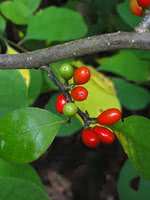Mon-Fri 9am - 5pm Mountain time
Wild Snowberry vs Spicebush
Symphoricarpos spp.
Lindera benzoin
CUSTOM GROW
NOT AVAILABLE THIS SEASON - MIGHT RETURN
Wild Snowberry is a mix of Common Snowberry and Western Snowberry. Each shrub's size, flower, and berry colour may vary.
This plant is abundant across the prairies. It can be planted alone or as a hedge in small yards. This shrub's ornamental berries persist into winter. Wild Snowberry can be a natural habitat and food source for various animals.
The Spicebush is an unique ornamental shrub that blooms with vibrant yellow flowers and bright green foliage. The foliage goes from green to yellow in the autumn, adding fall interest to your garden.The plant is dioecious, meaning that you will need male and female plants in order to harvest it’s red berries. Berries are only produced on female plants. The berries themselves aren’t that sweet, and are mostly enjoyed by birds and other wildlife.
The Spicebush, also commonly known as Common Spicebush, Northern Spicebush, Wild Allspice, and Benjamin Bush, is named after its distinctive spicy-sweet fragrance that comes from the flowers.

